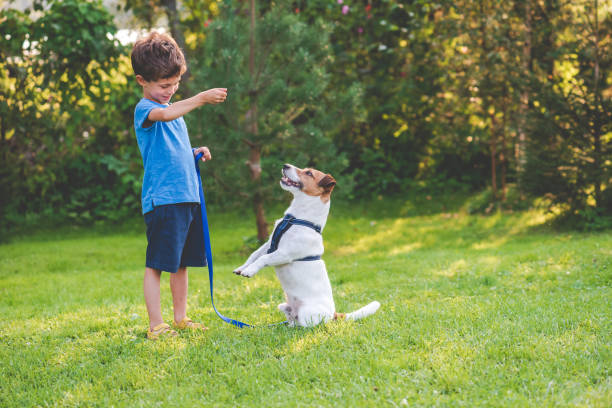
Teaching Advanced Tricks: Take Your Companion’s Skills to the Next Level

Unlock your furry friend’s full potential with advanced dog training techniques! Discover step-by-step guidance on how to teach pets advanced tricks and elevate their skills to the next level.
Have you ever wondered just how smart your furry friend could be? Whether you’re a proud dog parent or have a different animal companion, teaching advanced tricks can be a delightful and rewarding experience for both of you.
We often think about training our companions with basic commands like sit, stay, or fetch, but there’s a whole world of advanced dog training techniques that can take your beloved animal’s skills to new heights.
The Joy of Learning Together
A few years ago, I decided to teach my dog, Bella, a few advanced tricks. He had mastered the basics, and I wanted to challenge him (and myself) to learn something new.
One day, while watching a movie, I thought it would be amazing if Bella could fetch the remote for me. It seemed like an ambitious goal, but with a bit of patience and a lot of treats, Bella learned the trick in just a few weeks! The joy and excitement we both felt every time he successfully brought the remote were priceless.
This experience not only deepened our bond but also made me realize just how capable and intelligent our animal friends can be.
Why Teach Advanced Tricks?
Teaching advanced tricks isn’t just about showing off to friends and family, although that can be a fun bonus! It’s about providing mental stimulation, building confidence, and strengthening the bond between you and your furry friend.
Engaging in advanced training is a rewarding experience that can enhance the quality of life for both you and your beloved companion. It provides a host of benefits that enrich their lives and yours.
Here are five compelling reasons to engage in advanced training:
1. Mental Stimulation
Advanced tricks challenge your companion’s cognitive abilities, keeping their minds sharp and engaged. Just like humans, animals benefit from mental exercise, which can prevent boredom and decrease the likelihood of developing behavioral issues.
Complex tricks require them to think, problem-solve, and remember sequences, all of which contribute to their mental well-being.
2. Physical Exercise
Many advanced tricks involve physical movement, helping to keep your companion active and fit. Tricks like jumping through hoops, spinning, or playing dead can provide a fun and varied form of exercise.
Regular physical activity is crucial for maintaining a healthy weight and preventing conditions such as obesity, arthritis, and other health issues.
3. Increased Confidence
Mastering new skills can boost your companion’s confidence. As they successfully learn and perform advanced tricks, they gain a sense of achievement and pride.
This confidence can translate into other areas of their life, making them more comfortable in new situations and around new people.
4. Enhanced Bonding
Training sessions are a wonderful opportunity to strengthen the bond between you and your animal companion. The process of teaching and learning together fosters trust and deepens your connection.
It also improves communication, as you learn to understand each other better through the training cues and responses.
5. Reduced Behavioral Issues
A well-trained companion is often better behaved. Advanced training can reduce boredom and anxiety, which are common causes of problem behaviors.
6. Practical Benefits
Beyond the fun and entertainment, some advanced tricks can be incredibly practical. For instance, teaching your dog to fetch specific objects or open doors can be helpful in everyday life.
These skills can also be particularly beneficial for individuals with disabilities, as trained animals can assist with various tasks around the home.
Advanced Pets Training Techniques: Getting Started
Before diving into advanced tricks, it’s essential to ensure that your companion has a solid understanding of basic commands. Think of it as building a foundation; without it, the more complex tricks might crumble.
I remember a time when I thought my cat, Dolly, was too independent to learn tricks. She always seemed more interested in doing her own thing. One day, I decided to give it a shot and started with something simple: teaching her to high-five. To my surprise, Dolly picked it up quickly!
Now, she loves to high-five for treats, and it’s become a fun way for us to bond. It just goes to show that with a bit of patience and creativity, you can teach almost any animal companion advanced tricks.
Once they’re confident with the basics, you can begin introducing more challenging skills.
1. Target Training
One of the most versatile advanced training techniques is target training. This involves teaching your companion to touch a specific object, like a stick or your hand, with their nose or paw.
Start by holding the object close to them and rewarding them with a treat when they make contact. Gradually increase the distance, encouraging them to move towards the target.
2. Spin and Twist
Teaching your animal friend to spin or twist is not only cute but also great for coordination. Begin by holding a treat close to their nose and slowly moving it in a circle. As they follow the treat, they’ll naturally start to spin.
Use a command like “spin” or “twist” and reward them once they complete the circle. This trick can be a fun way to warm up before learning more complex skills.
3. Play Dead
The classic “play dead” trick is always a crowd-pleaser. Start by asking your companion to lie down. Hold a treat near their nose and slowly move it towards their shoulder, encouraging them to roll onto their side.
Use a command like “bang” or “play dead” and give them a treat once they’re lying still. With practice, they’ll learn to associate the command with the action.
4. Fetch Specific Objects
If your furry friend loves to play fetch, why not teach them to fetch specific objects? You can start with simple items like a toy or a ball and gradually move to more complex objects like your shoes or the TV remote.
Start by naming the object and giving a command like “fetch the ball.” Reward them when they bring the correct item. This trick is not only fun but also practical!
How to Teach Pets Advanced Tricks: Tips for Success
Teaching advanced tricks requires patience, consistency, and plenty of positive reinforcement. Here are some tips to help you succeed:
1. Keep Training Sessions Short and Fun:
Your companion’s attention span may not be very long, so keep sessions short and engaging. Aim for 5-10 minutes and always end on a positive note.
2. Use High-Value Treats:
Use treats that your friend finds irresistible. This will keep them motivated and excited to learn.
3. Be Patient and Consistent: Every animal learns at their own pace. If they don’t get it right away, don’t get discouraged. Consistency is key; practice regularly and stay positive.
4. Break Down the Trick into Smaller Steps:
If a trick seems too challenging, break it down into smaller, manageable steps. Reward each small achievement and gradually build up to the full trick.
5. Avoid Overtraining:
Just like us, our animal companions can get tired or frustrated. If they seem uninterested or distracted, take a break and try again later.
Advanced Training: Building on Existing Skills
Once your furry friend has mastered a few advanced tricks, you can build on these skills to teach even more complex behaviors. For example:
– Open and Close Doors:
Start by teaching them to push a door with their nose or paw. Once they’ve got the hang of it, you can train them to open and close doors on command.
– Put Toys Away:
Teach your companion to pick up their toys and put them in a designated bin. This trick not only impresses but also helps keep your home tidy!
– Ring a Bell to Go Outside:
If you have a dog, you can teach them to ring a bell when they want to go outside. Hang a bell by the door and encourage them to nudge it with their nose or paw.
Reward them when they make the bell ring, and they’ll soon associate the sound with going outside.
Overcoming Challenges
Every training journey comes with its challenges. Here are some common issues and how to overcome them:
– Lack of Interest:
If your furry friend seems uninterested, try switching up the treats or training in a different environment. Sometimes a change of scenery can make a big difference.
– Distractions:
Minimize distractions during training sessions by choosing a quiet location. As your companion becomes more skilled, gradually introduce distractions to improve their focus.
– Frustration:
If you or your animal friend becomes frustrated, take a break. Training should be a positive experience, so it’s essential to keep things light and enjoyable.
Ready to Level Up Your Training?
Teaching advanced tricks to your furry companion is a fantastic way to challenge their minds, provide physical exercise, and deepen your bond.
Whether you have a playful pup, a clever kitty, or another animal friend, there’s no limit to the tricks they can learn with the right approach and a bit of patience.
Remember, the journey of learning is just as important as the destination. Enjoy the process, celebrate each small victory, and cherish the moments of connection and joy that come with it.
So, grab some treats, gather your patience, and get ready to take your companion’s skills to the next level with advanced training!
ABOUT AUTHOR

Alison Housten
Lorem ipsum dolor sit amet, consectetur adipiscing elit. Ut elit tellus, luctus nec ullam.

RECENT POSTS



